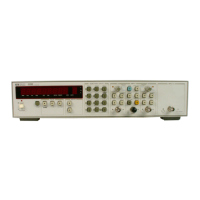from negative voltages during circuit power-up which would damage U33. Capacitor
C96
compensates the op-
amp. The input offset nulling for the op-amp loop
is
determined
by
resistors R67, R68, and R86. This divider cir-
cuit provides
&
10 mV of offset adjustment.
8-143. Potentiometer R102 sets the gain for the current-to-voltage converter loop by adjusting the current sup-
plied to DAC U33 at pin 15 from U35, the 2.5 volt reference IC.
8-144: The voltage level at the output of U25A
is
always negative
as
a result of the signal inversion by U25A op-
amp.
The
analog CMOS switch U26B and op-amp U25D work together to convert this nonpositive voltage to
either a positive or negative level. The state of the output
TTL
voltage at U26B pin 10 decides the polarity of the
output of the signal at
U25D pin 14. The
TTL
voltage comes from the Measurement MCU. When this line is at a
TTL
HIGH, the U26B switch closes the contacts between pins
1
and 15, and the output of U25A appears at the
output of
U25D unaltered. In this case, U25D is acting as a noninverting buffer with resistors R69 and R70 set-
ting a gain of
unity
or
1.
8-145. When the Measurement MCU sends a
TTL LOW
to the CMOS switch, the contacts close between pins
2 and 15, and the input of
U25D pin 12 is set to zero volts by its connection to U33 pin
1.
The op-amp U25D in-
verts the negative voltage from
U25A resulting in a positive voltage with a gain of
1
at U25D pin 14.
8-146. The reference voltage input to the DAC is
+2.5 volts. The output of the current-to-voltage converter,
UZA, ranges from zero to -2.5 volts. Since the 8-bit DAC has the potential for 256 current increments, the volt-
age resolution of the DAC circuit is approximately 10
mV. Because of the scaling that takes place in the Input
Amplifier Block
(X2),
the DAC resolution for the trigger level of the instrument is 20 mV. The output voltage of
the buffer
U25D ranges from -2.5 to +2.5 volts. The trigger level voltages of the HP 5334B has a range of -5.1
to
+
5.1 volts. The dc voltages from the DAC block are amplified in the Low Frequency op-amp loop of the
Input
Amplifier Block. The Measurement MCU can instruct the DAC to output either a steady dc voltage for
setting trigger levels, or a rapidly shifting dc voltage for reading the peaks and levels of signals input to
Channe A.
8-147.
SWITCHING SECTION. The second half of the DAC circuit, the DAC switching section, contains
three analog CMOS switches and a comparator. The DAC or Front Panel Control Switch,
U26A, passes the dc
voltage from either the DAC or the Front Panel Control to the Trigger Level Control Switch,
U27C, and the Sen-
sitivity Control Switch,
U28C. These switches then direct the voltage to the appropriate circuit in the Input
Amplifier Block as required by the selected measurement function. The Trigger Level Control Switch also works
with the Read
~evels Comparator, U36B, to compare the DAC voltage with the Front Panel Control voltage
when operating in the READ LEVELS-Trigger levels mode. All three CMOS switches are controlled by the
Measurement MCU.
8-148. The Measurement MCU determines which control voltage will be sent on to the following switches from
U26A. The Measurement MCU selects the voltage via the switch control line at pin 11. A TTL LOW from the
MCU connects the Front Panel Control voltage from
U26A pin 12 to pin 14. A
TTL
HIGH connects the DAC
voltage from
U26A pin 13 to pin 14.
8-149. The Trigger Level Control Switch,
U27C, selects the type of trigger level control voltage for the Channel
A Input Amplifier. A
TTL HIGH from the Measurement MCU at U27C pin 9 sets the trigger level for the in-
strument to
0 volts by connecting the trigger level control line (pin
4)
to ground at pin 3. A TTL LOW at pin
9
connects the DAC voltage or the Front Panel Control voltage from U26A to the trigger level control line via
pin 5.
8-150. The Sensitivity Control Switch,
UBC, selects the type of sensitivity level control voltage for Channel A
Input Amplifier. A
TTL
HIGH from the Measurement MCU at U28C pin 9 connects the voltage from either the
DAC or the Front Panel from
U26A to the sensitivity control line via U28C pin 3. A TTL LOW at pin
9
closes
the contacts between pins 5 and 4. This sets the sensitivity level to the Input Amplifier Schmitt stage to
ap-
HP 5334B
-
Service Manual
8-21

